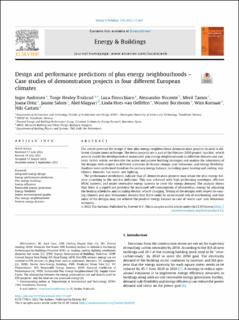| dc.contributor.author | Andresen, Inger | |
| dc.contributor.author | Trulsrud, Tonje Healey | |
| dc.contributor.author | Finocchiaro, Luca | |
| dc.contributor.author | Nocente, Alessandro | |
| dc.contributor.author | Tamm, Meril | |
| dc.contributor.author | Ortiz, Joana | |
| dc.contributor.author | Salom, Jaume | |
| dc.contributor.author | Magyari, Ábel | |
| dc.contributor.author | Oeffelen, Linda Hoes-van | |
| dc.contributor.author | Borsboom, Wouter | |
| dc.contributor.author | Kornaat, Wim | |
| dc.contributor.author | Gaitani, Niki | |
| dc.date.accessioned | 2022-09-13T15:19:46Z | |
| dc.date.available | 2022-09-13T15:19:46Z | |
| dc.date.created | 2022-09-09T13:20:10Z | |
| dc.date.issued | 2022 | |
| dc.identifier.issn | 0378-7788 | |
| dc.identifier.uri | https://hdl.handle.net/11250/3017591 | |
| dc.description.abstract | The article presents the design of four plus energy neighbourhood demonstration projects located in different climate zones in Europe. The demo projects are a part of the Horizon 2020 project ‘syn.ikia’, which aims to enable the development of sustainable plus energy neighbourhoods in different climates and contexts. In this article, we describe the active and passive building strategies and analyse the robustness of the designs with respect to different scenarios of climate change, user behaviour, and energy flexibility. Analyses were performed based on the primary energy balance, including space heating and cooling, ventilation, domestic hot water, and lighting.
The performance predictions indicate that all demonstration projects may attain the plus energy balance according to the syn.ikia definition. This was achieved with high performing envelopes, efficient HVAC systems, and onsite renewable energy systems to cover the energy demand. The analysis shows that there is a significant potential for increased self-consumption of photovoltaic energy by adjusting the heating schedules and including electric vehicle charging. Testing of the designs with respect to varying climates and user-behaviours showed that there could be an increased risk of overheating, and that some of the designs may not achieve the positive energy balance in case of ‘worst case’ user behaviour scenarios. | en_US |
| dc.language.iso | eng | en_US |
| dc.publisher | Elsevier | en_US |
| dc.rights.uri | http://creativecommons.org/licenses/by/4.0/ | |
| dc.subject | Integrated energy design | en_US |
| dc.subject | Energy performance prediction | en_US |
| dc.subject | Plus energy buildings | en_US |
| dc.subject | Energy efficiency | en_US |
| dc.subject | Renewable energy generation | en_US |
| dc.subject | Energy flexibility | en_US |
| dc.subject | Indoor environmental quality | en_US |
| dc.subject | Plus energy neighbourhoods | en_US |
| dc.subject | Positive energy districts | en_US |
| dc.title | Design and performance predictions of plus energy neighbourhoods – Case studies of demonstration projects in four different European climates | en_US |
| dc.type | Peer reviewed | en_US |
| dc.type | Journal article | en_US |
| dc.description.version | publishedVersion | en_US |
| dc.rights.holder | © 2022 The authors | en_US |
| dc.subject.nsi | VDP::Teknologi: 500 | en_US |
| dc.source.volume | 274 | en_US |
| dc.source.journal | Energy and Buildings | en_US |
| dc.identifier.cristin | 2050312 | |
| dc.relation.project | EU – Horisont Europa (EC/HEU): 869918 | en_US |
| dc.rights.license | CC BY 4.0 | |
| dc.source.articlenumber | 112447 | en_US |
| cristin.ispublished | true | |
| cristin.fulltext | original | |
| cristin.qualitycode | 2 | |

